The True Contribution of Collectivism Leadership.
VerifiedAdded on 2022/05/23
|10
|2218
|33
AI Summary
Contribute Materials
Your contribution can guide someone’s learning journey. Share your
documents today.

The True Contribution of Collectivism Leadership
Student: Paula Morales (2019000196)
Course Leader: Joshua Hayden
Course: Leadership and Self - PSY275 Spring 2022
Date Submitted: May 12, 2022
Date Due: May 12, 2022
Comments:
Grade:
Student: Paula Morales (2019000196)
Course Leader: Joshua Hayden
Course: Leadership and Self - PSY275 Spring 2022
Date Submitted: May 12, 2022
Date Due: May 12, 2022
Comments:
Grade:
Secure Best Marks with AI Grader
Need help grading? Try our AI Grader for instant feedback on your assignments.
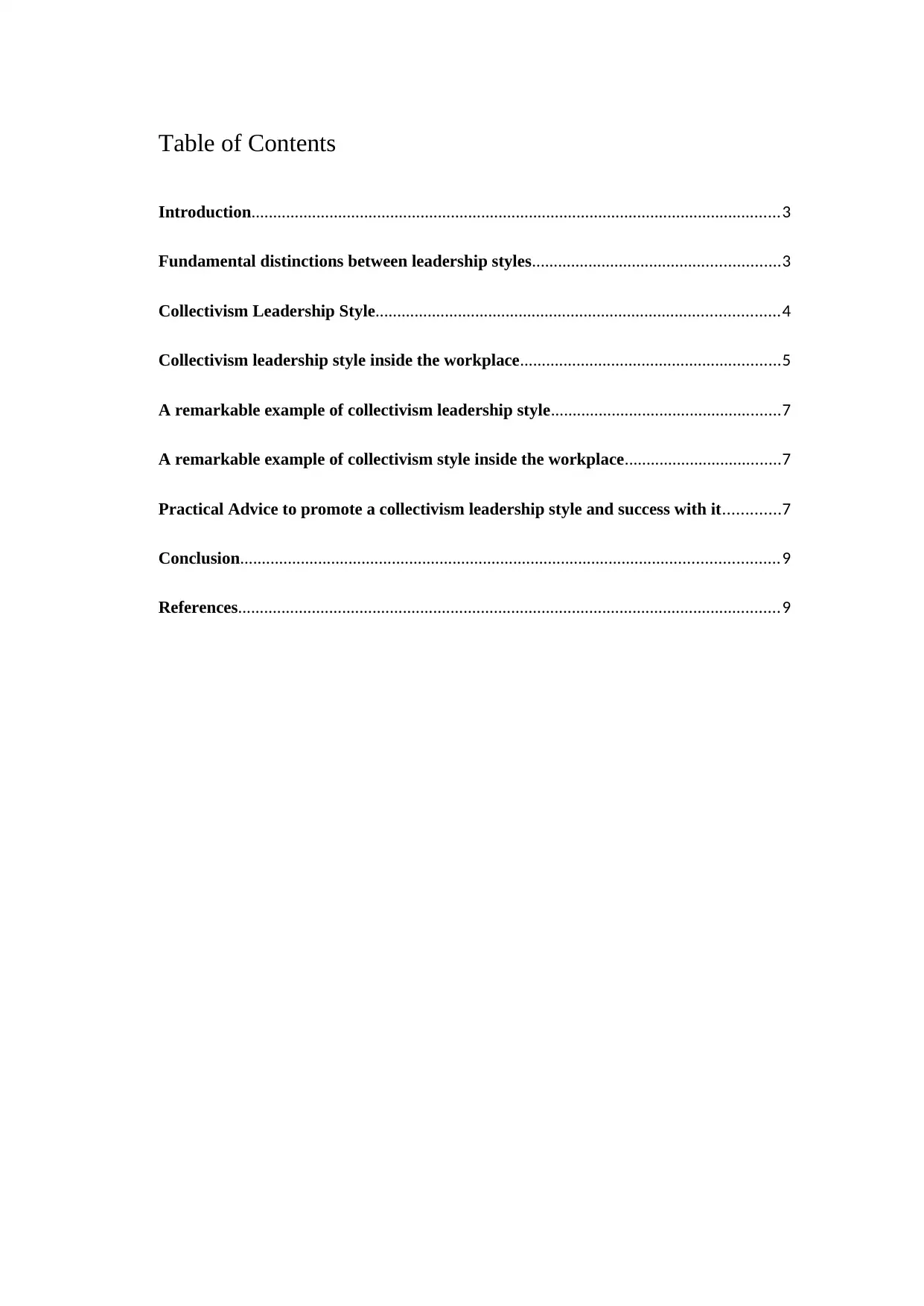
Table of Contents
Introduction..........................................................................................................................3
Fundamental distinctions between leadership styles.........................................................3
Collectivism Leadership Style.............................................................................................4
Collectivism leadership style inside the workplace............................................................5
A remarkable example of collectivism leadership style.....................................................7
A remarkable example of collectivism style inside the workplace....................................7
Practical Advice to promote a collectivism leadership style and success with it.............7
Conclusion............................................................................................................................9
References.............................................................................................................................9
Introduction..........................................................................................................................3
Fundamental distinctions between leadership styles.........................................................3
Collectivism Leadership Style.............................................................................................4
Collectivism leadership style inside the workplace............................................................5
A remarkable example of collectivism leadership style.....................................................7
A remarkable example of collectivism style inside the workplace....................................7
Practical Advice to promote a collectivism leadership style and success with it.............7
Conclusion............................................................................................................................9
References.............................................................................................................................9
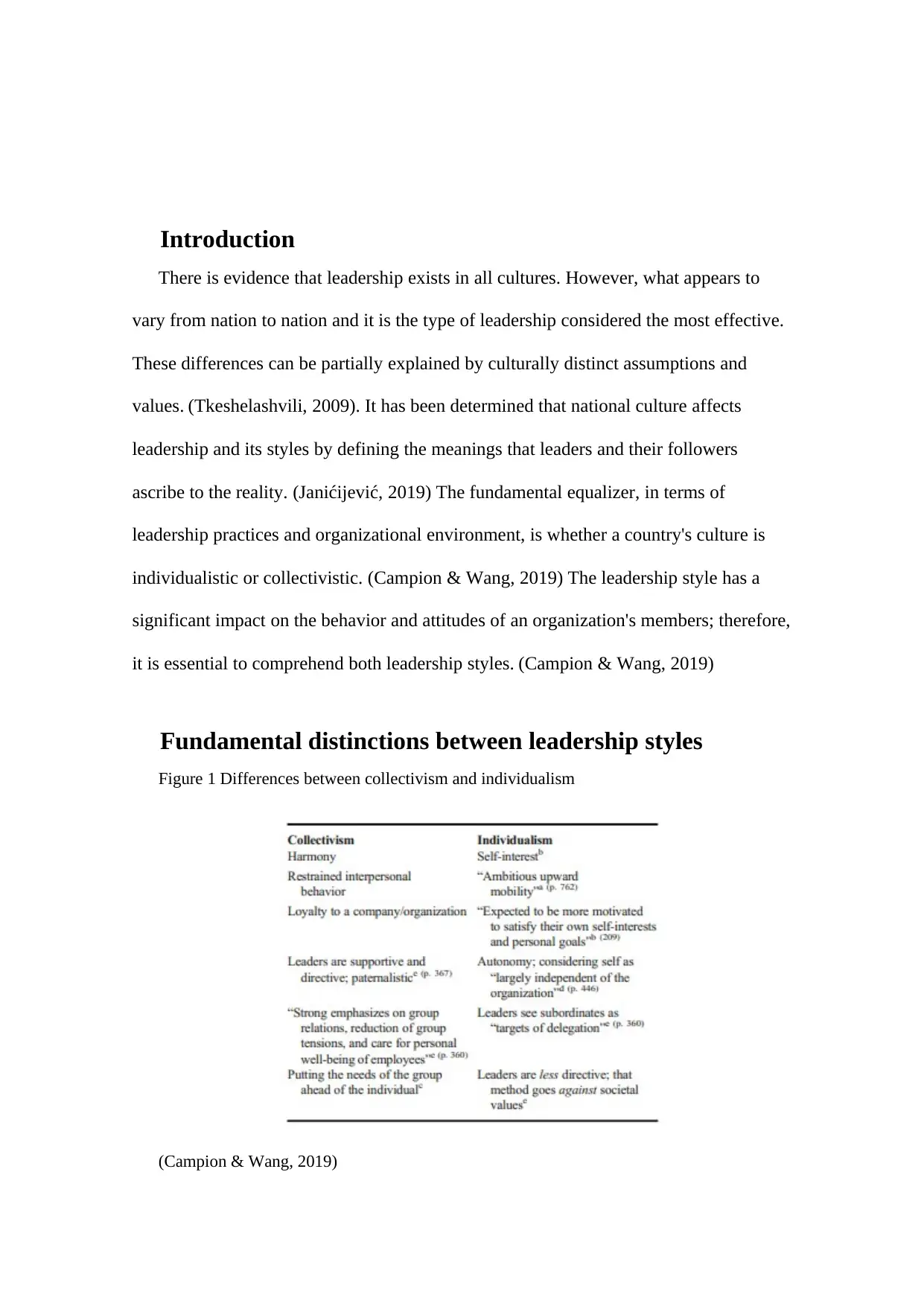
Introduction
There is evidence that leadership exists in all cultures. However, what appears to
vary from nation to nation and it is the type of leadership considered the most effective.
These differences can be partially explained by culturally distinct assumptions and
values. (Tkeshelashvili, 2009). It has been determined that national culture affects
leadership and its styles by defining the meanings that leaders and their followers
ascribe to the reality. (Janićijević, 2019) The fundamental equalizer, in terms of
leadership practices and organizational environment, is whether a country's culture is
individualistic or collectivistic. (Campion & Wang, 2019) The leadership style has a
significant impact on the behavior and attitudes of an organization's members; therefore,
it is essential to comprehend both leadership styles. (Campion & Wang, 2019)
Fundamental distinctions between leadership styles
Figure 1 Differences between collectivism and individualism
(Campion & Wang, 2019)
There is evidence that leadership exists in all cultures. However, what appears to
vary from nation to nation and it is the type of leadership considered the most effective.
These differences can be partially explained by culturally distinct assumptions and
values. (Tkeshelashvili, 2009). It has been determined that national culture affects
leadership and its styles by defining the meanings that leaders and their followers
ascribe to the reality. (Janićijević, 2019) The fundamental equalizer, in terms of
leadership practices and organizational environment, is whether a country's culture is
individualistic or collectivistic. (Campion & Wang, 2019) The leadership style has a
significant impact on the behavior and attitudes of an organization's members; therefore,
it is essential to comprehend both leadership styles. (Campion & Wang, 2019)
Fundamental distinctions between leadership styles
Figure 1 Differences between collectivism and individualism
(Campion & Wang, 2019)
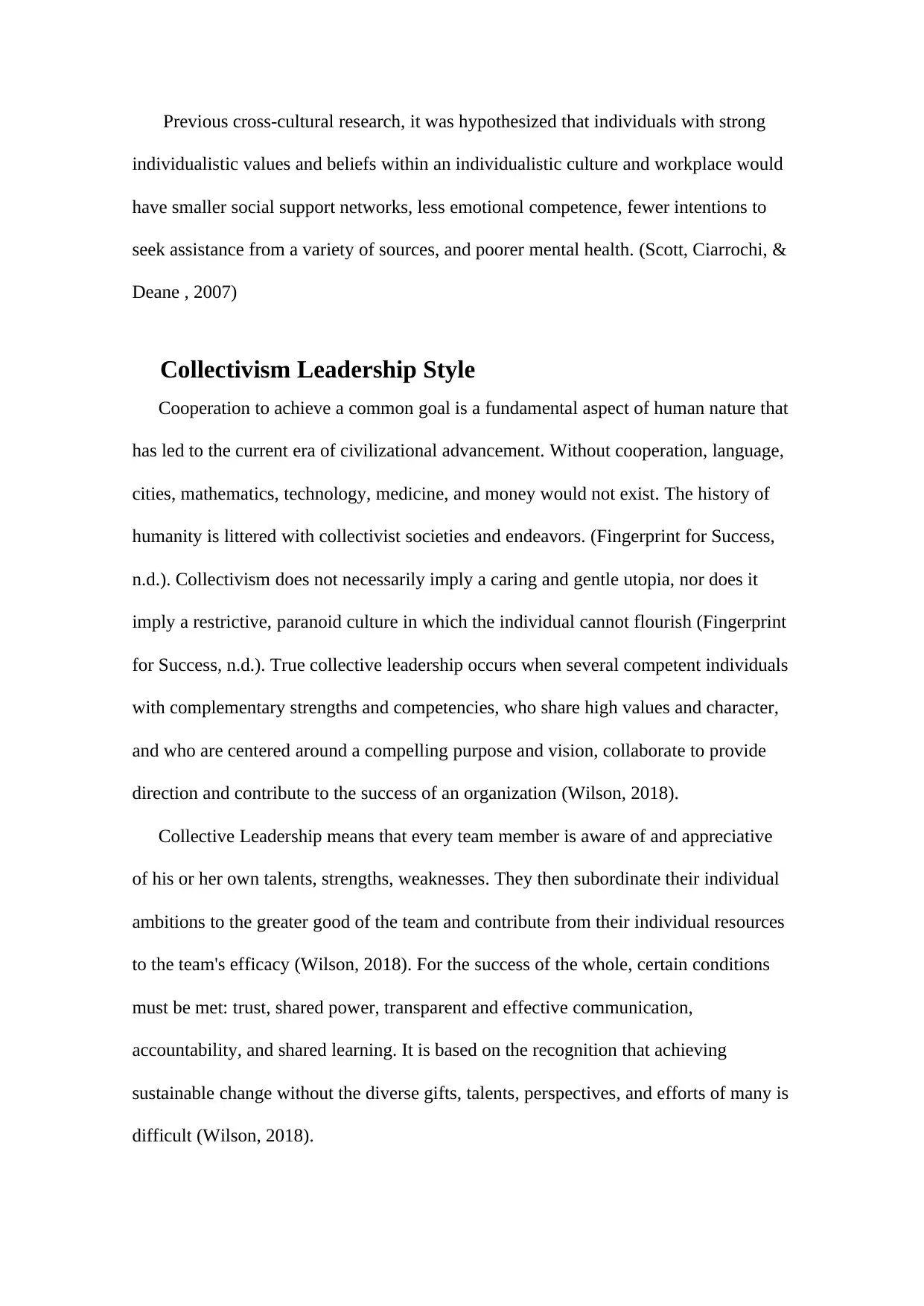
Previous cross-cultural research, it was hypothesized that individuals with strong
individualistic values and beliefs within an individualistic culture and workplace would
have smaller social support networks, less emotional competence, fewer intentions to
seek assistance from a variety of sources, and poorer mental health. (Scott, Ciarrochi, &
Deane , 2007)
Collectivism Leadership Style
Cooperation to achieve a common goal is a fundamental aspect of human nature that
has led to the current era of civilizational advancement. Without cooperation, language,
cities, mathematics, technology, medicine, and money would not exist. The history of
humanity is littered with collectivist societies and endeavors. (Fingerprint for Success,
n.d.). Collectivism does not necessarily imply a caring and gentle utopia, nor does it
imply a restrictive, paranoid culture in which the individual cannot flourish (Fingerprint
for Success, n.d.). True collective leadership occurs when several competent individuals
with complementary strengths and competencies, who share high values and character,
and who are centered around a compelling purpose and vision, collaborate to provide
direction and contribute to the success of an organization (Wilson, 2018).
Collective Leadership means that every team member is aware of and appreciative
of his or her own talents, strengths, weaknesses. They then subordinate their individual
ambitions to the greater good of the team and contribute from their individual resources
to the team's efficacy (Wilson, 2018). For the success of the whole, certain conditions
must be met: trust, shared power, transparent and effective communication,
accountability, and shared learning. It is based on the recognition that achieving
sustainable change without the diverse gifts, talents, perspectives, and efforts of many is
difficult (Wilson, 2018).
individualistic values and beliefs within an individualistic culture and workplace would
have smaller social support networks, less emotional competence, fewer intentions to
seek assistance from a variety of sources, and poorer mental health. (Scott, Ciarrochi, &
Deane , 2007)
Collectivism Leadership Style
Cooperation to achieve a common goal is a fundamental aspect of human nature that
has led to the current era of civilizational advancement. Without cooperation, language,
cities, mathematics, technology, medicine, and money would not exist. The history of
humanity is littered with collectivist societies and endeavors. (Fingerprint for Success,
n.d.). Collectivism does not necessarily imply a caring and gentle utopia, nor does it
imply a restrictive, paranoid culture in which the individual cannot flourish (Fingerprint
for Success, n.d.). True collective leadership occurs when several competent individuals
with complementary strengths and competencies, who share high values and character,
and who are centered around a compelling purpose and vision, collaborate to provide
direction and contribute to the success of an organization (Wilson, 2018).
Collective Leadership means that every team member is aware of and appreciative
of his or her own talents, strengths, weaknesses. They then subordinate their individual
ambitions to the greater good of the team and contribute from their individual resources
to the team's efficacy (Wilson, 2018). For the success of the whole, certain conditions
must be met: trust, shared power, transparent and effective communication,
accountability, and shared learning. It is based on the recognition that achieving
sustainable change without the diverse gifts, talents, perspectives, and efforts of many is
difficult (Wilson, 2018).
Secure Best Marks with AI Grader
Need help grading? Try our AI Grader for instant feedback on your assignments.
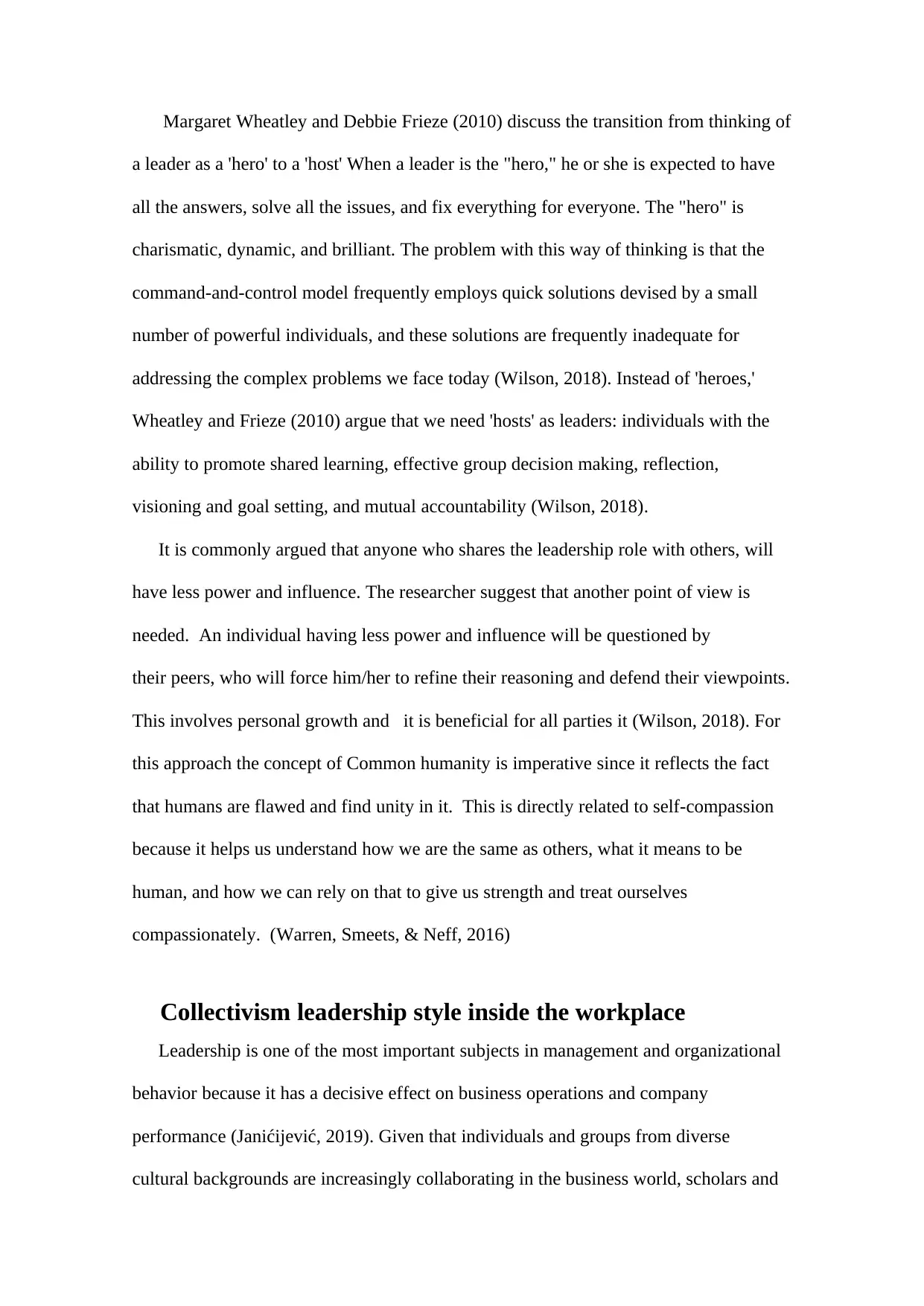
Margaret Wheatley and Debbie Frieze (2010) discuss the transition from thinking of
a leader as a 'hero' to a 'host' When a leader is the "hero," he or she is expected to have
all the answers, solve all the issues, and fix everything for everyone. The "hero" is
charismatic, dynamic, and brilliant. The problem with this way of thinking is that the
command-and-control model frequently employs quick solutions devised by a small
number of powerful individuals, and these solutions are frequently inadequate for
addressing the complex problems we face today (Wilson, 2018). Instead of 'heroes,'
Wheatley and Frieze (2010) argue that we need 'hosts' as leaders: individuals with the
ability to promote shared learning, effective group decision making, reflection,
visioning and goal setting, and mutual accountability (Wilson, 2018).
It is commonly argued that anyone who shares the leadership role with others, will
have less power and influence. The researcher suggest that another point of view is
needed. An individual having less power and influence will be questioned by
their peers, who will force him/her to refine their reasoning and defend their viewpoints.
This involves personal growth and it is beneficial for all parties it (Wilson, 2018). For
this approach the concept of Common humanity is imperative since it reflects the fact
that humans are flawed and find unity in it. This is directly related to self-compassion
because it helps us understand how we are the same as others, what it means to be
human, and how we can rely on that to give us strength and treat ourselves
compassionately. (Warren, Smeets, & Neff, 2016)
Collectivism leadership style inside the workplace
Leadership is one of the most important subjects in management and organizational
behavior because it has a decisive effect on business operations and company
performance (Janićijević, 2019). Given that individuals and groups from diverse
cultural backgrounds are increasingly collaborating in the business world, scholars and
a leader as a 'hero' to a 'host' When a leader is the "hero," he or she is expected to have
all the answers, solve all the issues, and fix everything for everyone. The "hero" is
charismatic, dynamic, and brilliant. The problem with this way of thinking is that the
command-and-control model frequently employs quick solutions devised by a small
number of powerful individuals, and these solutions are frequently inadequate for
addressing the complex problems we face today (Wilson, 2018). Instead of 'heroes,'
Wheatley and Frieze (2010) argue that we need 'hosts' as leaders: individuals with the
ability to promote shared learning, effective group decision making, reflection,
visioning and goal setting, and mutual accountability (Wilson, 2018).
It is commonly argued that anyone who shares the leadership role with others, will
have less power and influence. The researcher suggest that another point of view is
needed. An individual having less power and influence will be questioned by
their peers, who will force him/her to refine their reasoning and defend their viewpoints.
This involves personal growth and it is beneficial for all parties it (Wilson, 2018). For
this approach the concept of Common humanity is imperative since it reflects the fact
that humans are flawed and find unity in it. This is directly related to self-compassion
because it helps us understand how we are the same as others, what it means to be
human, and how we can rely on that to give us strength and treat ourselves
compassionately. (Warren, Smeets, & Neff, 2016)
Collectivism leadership style inside the workplace
Leadership is one of the most important subjects in management and organizational
behavior because it has a decisive effect on business operations and company
performance (Janićijević, 2019). Given that individuals and groups from diverse
cultural backgrounds are increasingly collaborating in the business world, scholars and
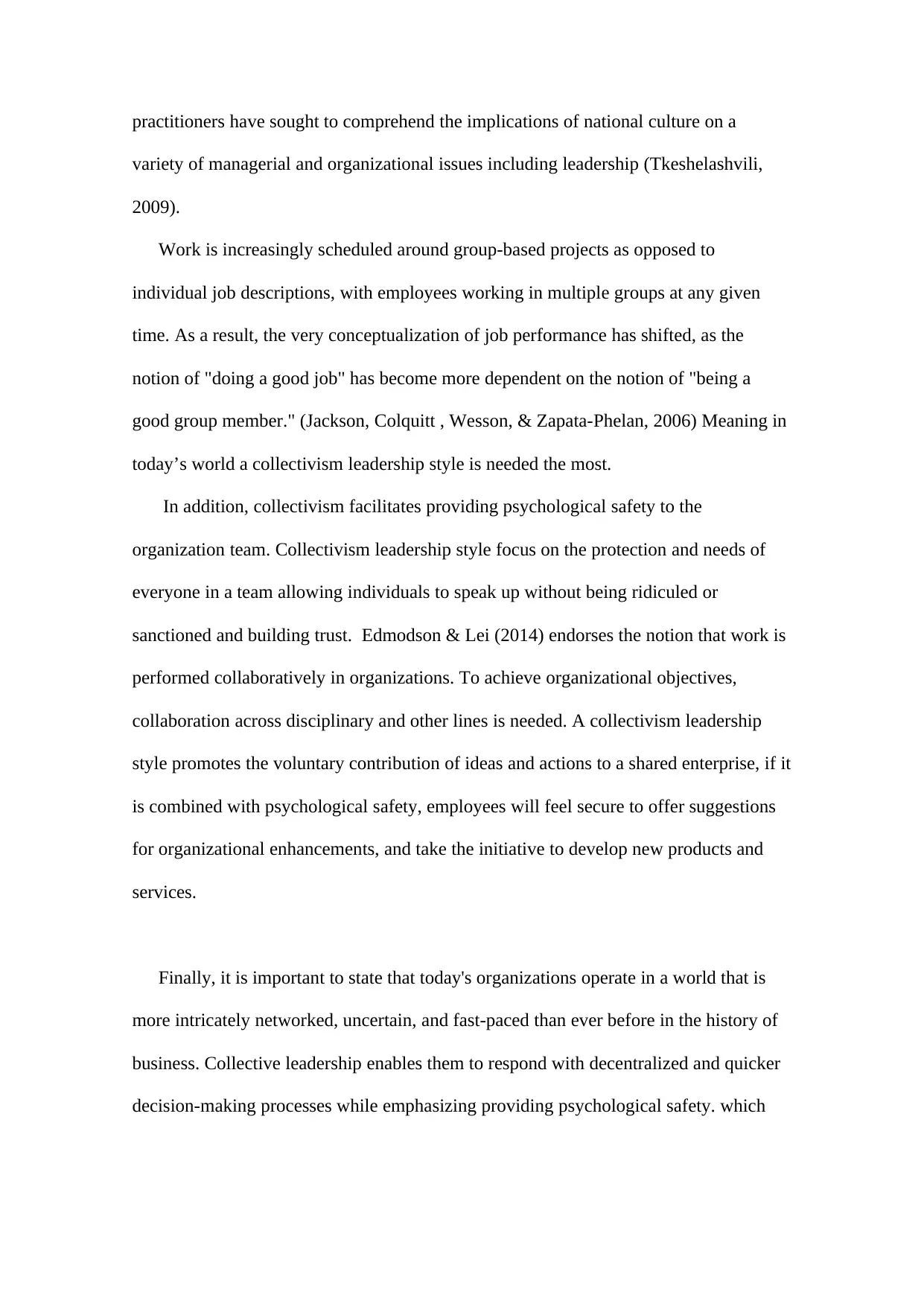
practitioners have sought to comprehend the implications of national culture on a
variety of managerial and organizational issues including leadership (Tkeshelashvili,
2009).
Work is increasingly scheduled around group-based projects as opposed to
individual job descriptions, with employees working in multiple groups at any given
time. As a result, the very conceptualization of job performance has shifted, as the
notion of "doing a good job" has become more dependent on the notion of "being a
good group member." (Jackson, Colquitt , Wesson, & Zapata-Phelan, 2006) Meaning in
today’s world a collectivism leadership style is needed the most.
In addition, collectivism facilitates providing psychological safety to the
organization team. Collectivism leadership style focus on the protection and needs of
everyone in a team allowing individuals to speak up without being ridiculed or
sanctioned and building trust. Edmodson & Lei (2014) endorses the notion that work is
performed collaboratively in organizations. To achieve organizational objectives,
collaboration across disciplinary and other lines is needed. A collectivism leadership
style promotes the voluntary contribution of ideas and actions to a shared enterprise, if it
is combined with psychological safety, employees will feel secure to offer suggestions
for organizational enhancements, and take the initiative to develop new products and
services.
Finally, it is important to state that today's organizations operate in a world that is
more intricately networked, uncertain, and fast-paced than ever before in the history of
business. Collective leadership enables them to respond with decentralized and quicker
decision-making processes while emphasizing providing psychological safety. which
variety of managerial and organizational issues including leadership (Tkeshelashvili,
2009).
Work is increasingly scheduled around group-based projects as opposed to
individual job descriptions, with employees working in multiple groups at any given
time. As a result, the very conceptualization of job performance has shifted, as the
notion of "doing a good job" has become more dependent on the notion of "being a
good group member." (Jackson, Colquitt , Wesson, & Zapata-Phelan, 2006) Meaning in
today’s world a collectivism leadership style is needed the most.
In addition, collectivism facilitates providing psychological safety to the
organization team. Collectivism leadership style focus on the protection and needs of
everyone in a team allowing individuals to speak up without being ridiculed or
sanctioned and building trust. Edmodson & Lei (2014) endorses the notion that work is
performed collaboratively in organizations. To achieve organizational objectives,
collaboration across disciplinary and other lines is needed. A collectivism leadership
style promotes the voluntary contribution of ideas and actions to a shared enterprise, if it
is combined with psychological safety, employees will feel secure to offer suggestions
for organizational enhancements, and take the initiative to develop new products and
services.
Finally, it is important to state that today's organizations operate in a world that is
more intricately networked, uncertain, and fast-paced than ever before in the history of
business. Collective leadership enables them to respond with decentralized and quicker
decision-making processes while emphasizing providing psychological safety. which
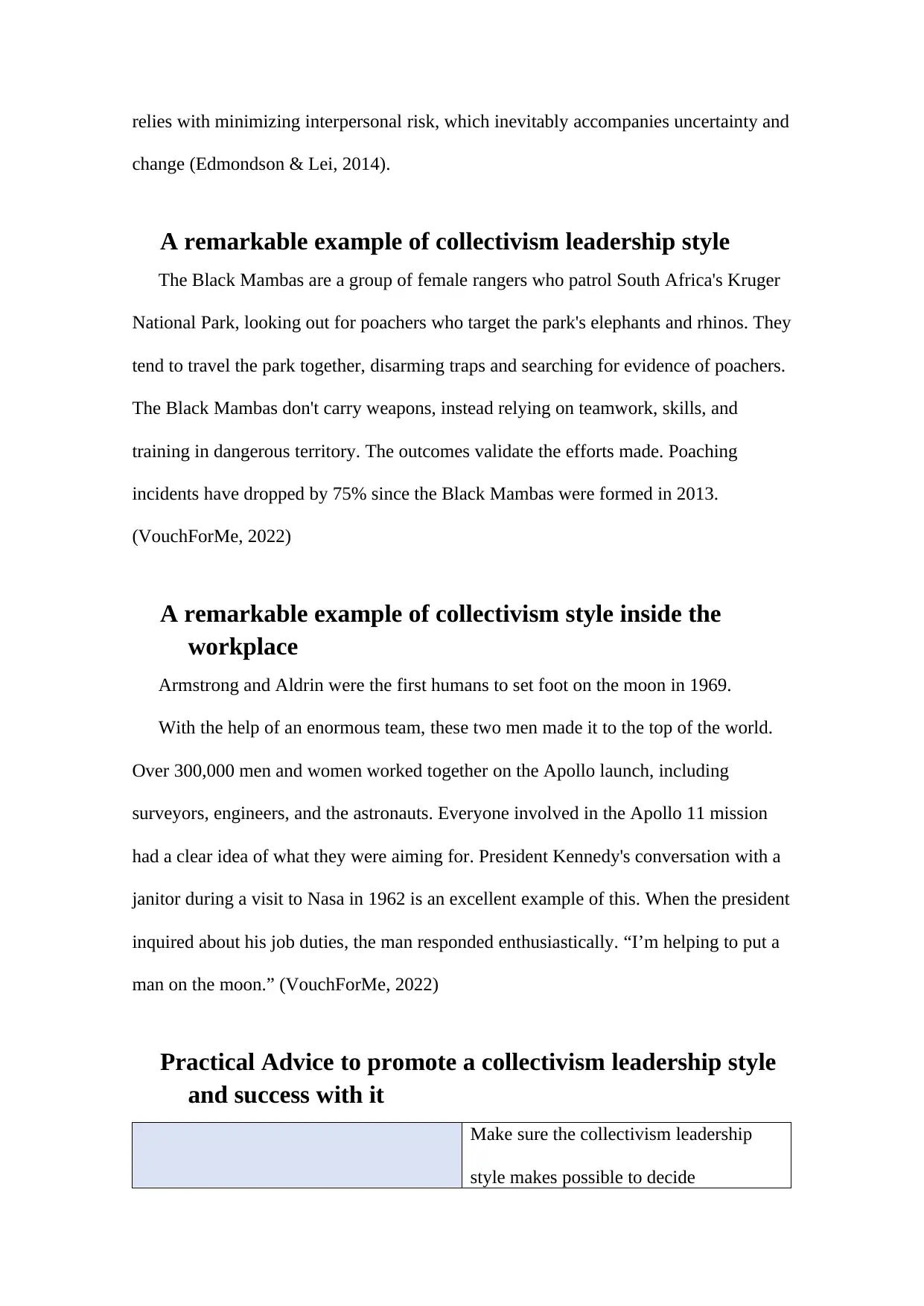
relies with minimizing interpersonal risk, which inevitably accompanies uncertainty and
change (Edmondson & Lei, 2014).
A remarkable example of collectivism leadership style
The Black Mambas are a group of female rangers who patrol South Africa's Kruger
National Park, looking out for poachers who target the park's elephants and rhinos. They
tend to travel the park together, disarming traps and searching for evidence of poachers.
The Black Mambas don't carry weapons, instead relying on teamwork, skills, and
training in dangerous territory. The outcomes validate the efforts made. Poaching
incidents have dropped by 75% since the Black Mambas were formed in 2013.
(VouchForMe, 2022)
A remarkable example of collectivism style inside the
workplace
Armstrong and Aldrin were the first humans to set foot on the moon in 1969.
With the help of an enormous team, these two men made it to the top of the world.
Over 300,000 men and women worked together on the Apollo launch, including
surveyors, engineers, and the astronauts. Everyone involved in the Apollo 11 mission
had a clear idea of what they were aiming for. President Kennedy's conversation with a
janitor during a visit to Nasa in 1962 is an excellent example of this. When the president
inquired about his job duties, the man responded enthusiastically. “I’m helping to put a
man on the moon.” (VouchForMe, 2022)
Practical Advice to promote a collectivism leadership style
and success with it
Make sure the collectivism leadership
style makes possible to decide
change (Edmondson & Lei, 2014).
A remarkable example of collectivism leadership style
The Black Mambas are a group of female rangers who patrol South Africa's Kruger
National Park, looking out for poachers who target the park's elephants and rhinos. They
tend to travel the park together, disarming traps and searching for evidence of poachers.
The Black Mambas don't carry weapons, instead relying on teamwork, skills, and
training in dangerous territory. The outcomes validate the efforts made. Poaching
incidents have dropped by 75% since the Black Mambas were formed in 2013.
(VouchForMe, 2022)
A remarkable example of collectivism style inside the
workplace
Armstrong and Aldrin were the first humans to set foot on the moon in 1969.
With the help of an enormous team, these two men made it to the top of the world.
Over 300,000 men and women worked together on the Apollo launch, including
surveyors, engineers, and the astronauts. Everyone involved in the Apollo 11 mission
had a clear idea of what they were aiming for. President Kennedy's conversation with a
janitor during a visit to Nasa in 1962 is an excellent example of this. When the president
inquired about his job duties, the man responded enthusiastically. “I’m helping to put a
man on the moon.” (VouchForMe, 2022)
Practical Advice to promote a collectivism leadership style
and success with it
Make sure the collectivism leadership
style makes possible to decide
Paraphrase This Document
Need a fresh take? Get an instant paraphrase of this document with our AI Paraphraser
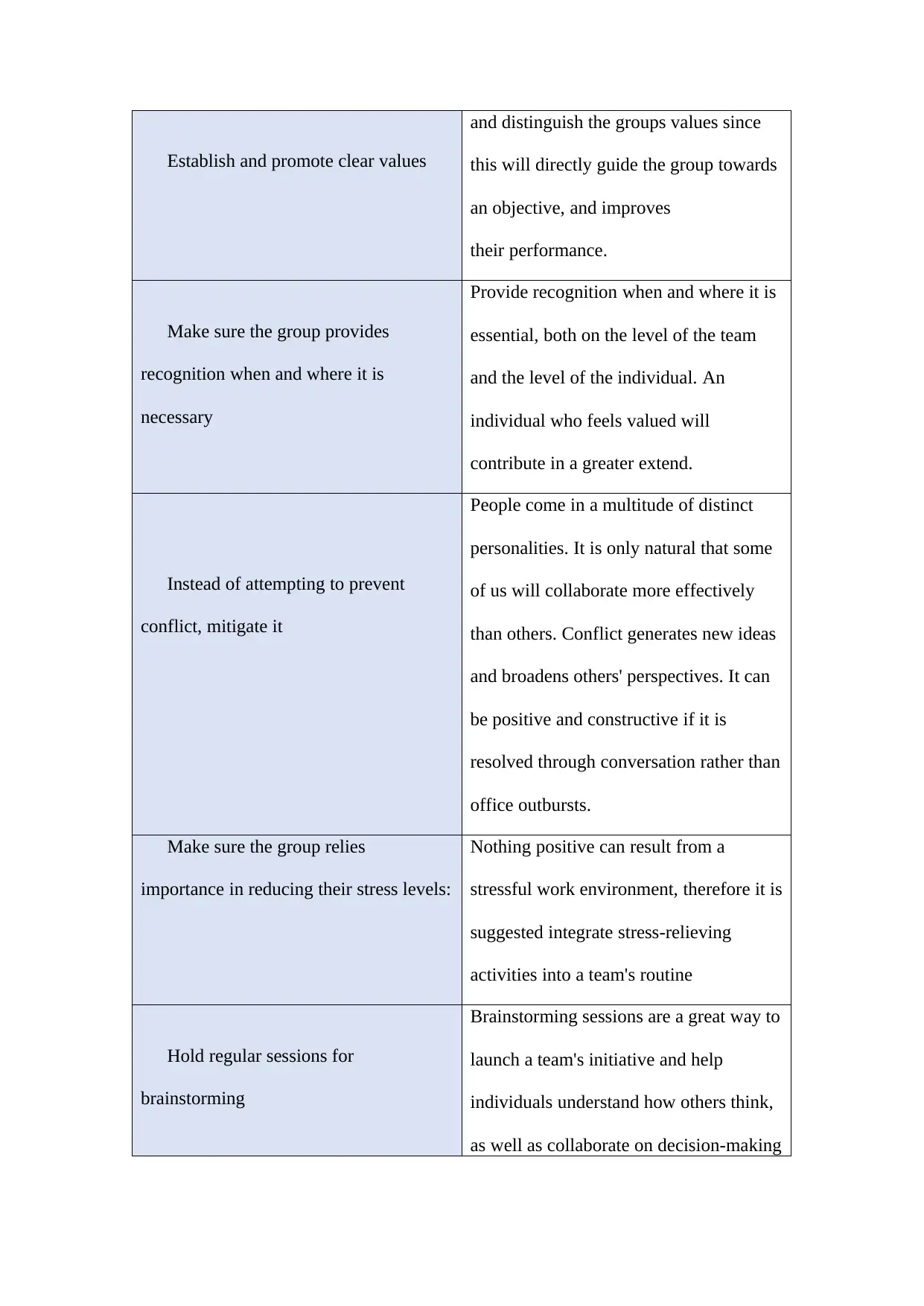
Establish and promote clear values
and distinguish the groups values since
this will directly guide the group towards
an objective, and improves
their performance.
Make sure the group provides
recognition when and where it is
necessary
Provide recognition when and where it is
essential, both on the level of the team
and the level of the individual. An
individual who feels valued will
contribute in a greater extend.
Instead of attempting to prevent
conflict, mitigate it
People come in a multitude of distinct
personalities. It is only natural that some
of us will collaborate more effectively
than others. Conflict generates new ideas
and broadens others' perspectives. It can
be positive and constructive if it is
resolved through conversation rather than
office outbursts.
Make sure the group relies
importance in reducing their stress levels:
Nothing positive can result from a
stressful work environment, therefore it is
suggested integrate stress-relieving
activities into a team's routine
Hold regular sessions for
brainstorming
Brainstorming sessions are a great way to
launch a team's initiative and help
individuals understand how others think,
as well as collaborate on decision-making
and distinguish the groups values since
this will directly guide the group towards
an objective, and improves
their performance.
Make sure the group provides
recognition when and where it is
necessary
Provide recognition when and where it is
essential, both on the level of the team
and the level of the individual. An
individual who feels valued will
contribute in a greater extend.
Instead of attempting to prevent
conflict, mitigate it
People come in a multitude of distinct
personalities. It is only natural that some
of us will collaborate more effectively
than others. Conflict generates new ideas
and broadens others' perspectives. It can
be positive and constructive if it is
resolved through conversation rather than
office outbursts.
Make sure the group relies
importance in reducing their stress levels:
Nothing positive can result from a
stressful work environment, therefore it is
suggested integrate stress-relieving
activities into a team's routine
Hold regular sessions for
brainstorming
Brainstorming sessions are a great way to
launch a team's initiative and help
individuals understand how others think,
as well as collaborate on decision-making
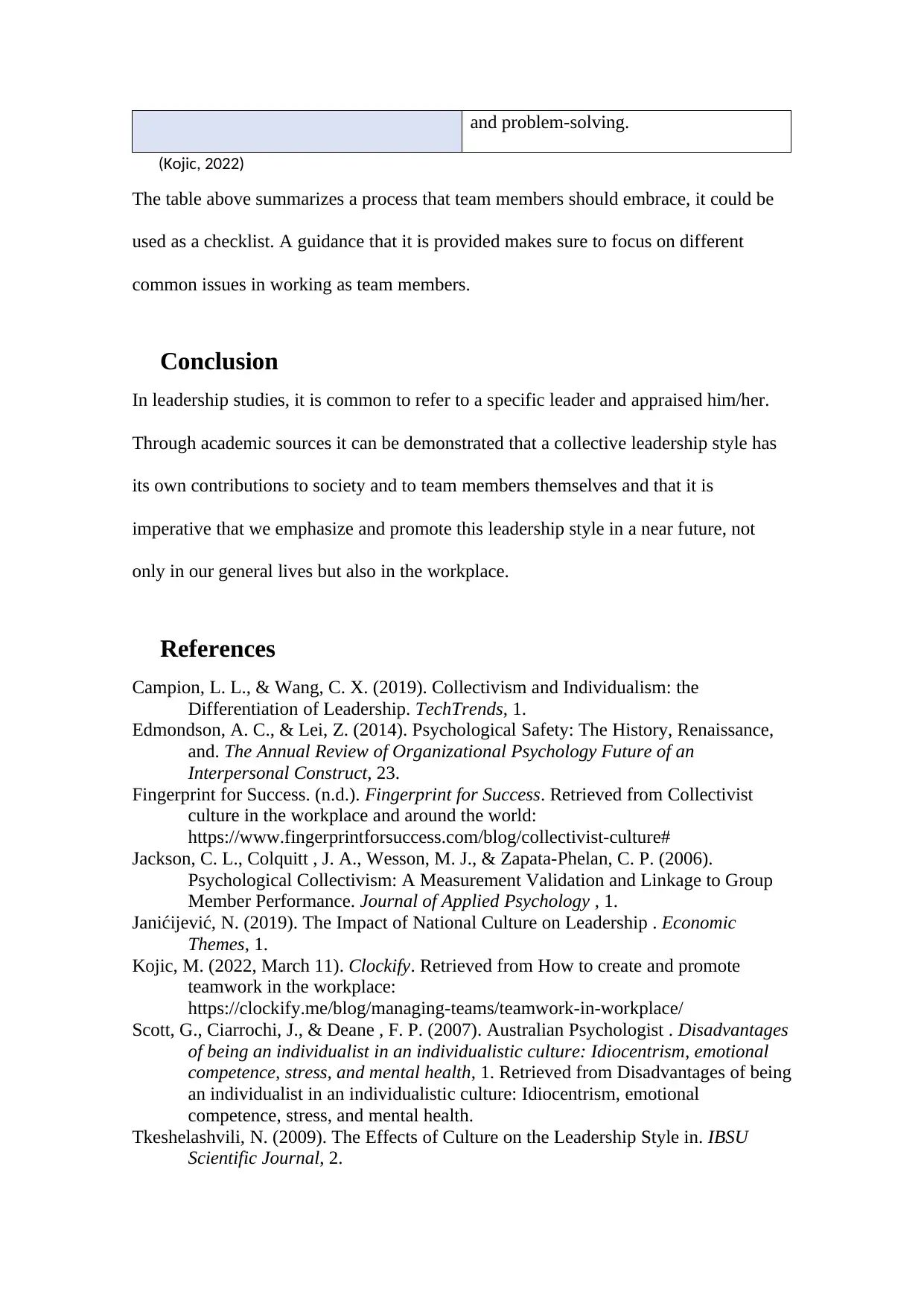
and problem-solving.
(Kojic, 2022)
The table above summarizes a process that team members should embrace, it could be
used as a checklist. A guidance that it is provided makes sure to focus on different
common issues in working as team members.
Conclusion
In leadership studies, it is common to refer to a specific leader and appraised him/her.
Through academic sources it can be demonstrated that a collective leadership style has
its own contributions to society and to team members themselves and that it is
imperative that we emphasize and promote this leadership style in a near future, not
only in our general lives but also in the workplace.
References
Campion, L. L., & Wang, C. X. (2019). Collectivism and Individualism: the
Differentiation of Leadership. TechTrends, 1.
Edmondson, A. C., & Lei, Z. (2014). Psychological Safety: The History, Renaissance,
and. The Annual Review of Organizational Psychology Future of an
Interpersonal Construct, 23.
Fingerprint for Success. (n.d.). Fingerprint for Success. Retrieved from Collectivist
culture in the workplace and around the world:
https://www.fingerprintforsuccess.com/blog/collectivist-culture#
Jackson, C. L., Colquitt , J. A., Wesson, M. J., & Zapata-Phelan, C. P. (2006).
Psychological Collectivism: A Measurement Validation and Linkage to Group
Member Performance. Journal of Applied Psychology , 1.
Janićijević, N. (2019). The Impact of National Culture on Leadership . Economic
Themes, 1.
Kojic, M. (2022, March 11). Clockify. Retrieved from How to create and promote
teamwork in the workplace:
https://clockify.me/blog/managing-teams/teamwork-in-workplace/
Scott, G., Ciarrochi, J., & Deane , F. P. (2007). Australian Psychologist . Disadvantages
of being an individualist in an individualistic culture: Idiocentrism, emotional
competence, stress, and mental health, 1. Retrieved from Disadvantages of being
an individualist in an individualistic culture: Idiocentrism, emotional
competence, stress, and mental health.
Tkeshelashvili, N. (2009). The Effects of Culture on the Leadership Style in. IBSU
Scientific Journal, 2.
(Kojic, 2022)
The table above summarizes a process that team members should embrace, it could be
used as a checklist. A guidance that it is provided makes sure to focus on different
common issues in working as team members.
Conclusion
In leadership studies, it is common to refer to a specific leader and appraised him/her.
Through academic sources it can be demonstrated that a collective leadership style has
its own contributions to society and to team members themselves and that it is
imperative that we emphasize and promote this leadership style in a near future, not
only in our general lives but also in the workplace.
References
Campion, L. L., & Wang, C. X. (2019). Collectivism and Individualism: the
Differentiation of Leadership. TechTrends, 1.
Edmondson, A. C., & Lei, Z. (2014). Psychological Safety: The History, Renaissance,
and. The Annual Review of Organizational Psychology Future of an
Interpersonal Construct, 23.
Fingerprint for Success. (n.d.). Fingerprint for Success. Retrieved from Collectivist
culture in the workplace and around the world:
https://www.fingerprintforsuccess.com/blog/collectivist-culture#
Jackson, C. L., Colquitt , J. A., Wesson, M. J., & Zapata-Phelan, C. P. (2006).
Psychological Collectivism: A Measurement Validation and Linkage to Group
Member Performance. Journal of Applied Psychology , 1.
Janićijević, N. (2019). The Impact of National Culture on Leadership . Economic
Themes, 1.
Kojic, M. (2022, March 11). Clockify. Retrieved from How to create and promote
teamwork in the workplace:
https://clockify.me/blog/managing-teams/teamwork-in-workplace/
Scott, G., Ciarrochi, J., & Deane , F. P. (2007). Australian Psychologist . Disadvantages
of being an individualist in an individualistic culture: Idiocentrism, emotional
competence, stress, and mental health, 1. Retrieved from Disadvantages of being
an individualist in an individualistic culture: Idiocentrism, emotional
competence, stress, and mental health.
Tkeshelashvili, N. (2009). The Effects of Culture on the Leadership Style in. IBSU
Scientific Journal, 2.

VouchForMe. (2022, December 09). VouchForMe. Retrieved from Great examples of
teamwork, from ancient Rome to the natural world.:
https://vouchforme.co/great-examples-of-teamwork/
Warren, R., Smeets, E., & Neff, K. (2016, December). CurrentPsychiatry. Retrieved
from Self-criticism and self-compassion: https://self-compassion.org/wp-
content/uploads/2016/12/Self-Criticism.pdf
Wilson, R. (2018, Agust 23). Growing Organizations . Retrieved from Collective
Leadership – The What, Why, And How:
https://growingorganisations.com/collective-leadership-what-why-how/
teamwork, from ancient Rome to the natural world.:
https://vouchforme.co/great-examples-of-teamwork/
Warren, R., Smeets, E., & Neff, K. (2016, December). CurrentPsychiatry. Retrieved
from Self-criticism and self-compassion: https://self-compassion.org/wp-
content/uploads/2016/12/Self-Criticism.pdf
Wilson, R. (2018, Agust 23). Growing Organizations . Retrieved from Collective
Leadership – The What, Why, And How:
https://growingorganisations.com/collective-leadership-what-why-how/
1 out of 10
Your All-in-One AI-Powered Toolkit for Academic Success.
+13062052269
info@desklib.com
Available 24*7 on WhatsApp / Email
![[object Object]](/_next/static/media/star-bottom.7253800d.svg)
Unlock your academic potential
© 2024 | Zucol Services PVT LTD | All rights reserved.